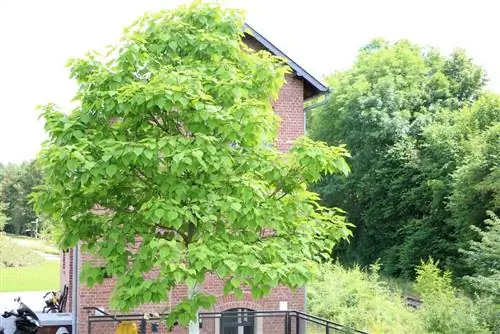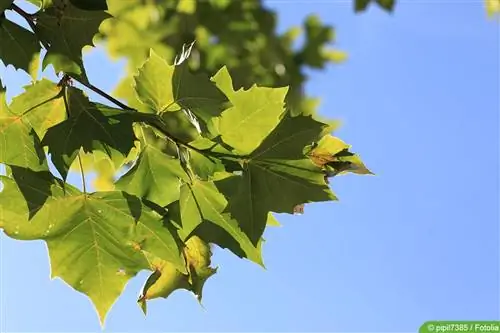- Author admin [email protected].
- Public 2023-12-17 03:39.
- Last modified 2025-06-01 06:48.
The Catalpa bignoniodes comes from southeastern North America and often reaches a height of around 18 meters. If you want to plant this decorative shade provider in your home garden, you must have enough space available. The maintenance effort, however, is manageable; only young trees need a little more attention in the first few years.
Location
In the wild, the common trumpet tree prefers to grow in warm regions on river banks and floodplains. It is considered to be very heat-resistant and can easily cope with direct sunlight. However, it prefers a place that is somewhat sheltered from the wind because its foliage is extremely large and heavy. This means there is a risk that the shoots could break, especially in strong winds. However, the tree should under no circumstances be left in a completely calm place because it needs some wind so that the leaves can dry well after the rain. Furthermore, the following aspects must be taken into account when choosing a location:
- Roots are sensitive to disturbances
- therefore do not plant on a lawn
- and don't integrate it into beds
Neighbors
The exotic deciduous tree impresses with its monumental effect, which is why it should preferably be given a single place. Planting next to another trumpet tree should be avoided if possible, otherwise the trees will draw nutrients from each other from the soil. However, since the Catalpa bignonioides is a heart-rooted plant, its roots can easily be planted with various plants:
- Funkia
- Ferns
- Shade Plants
- robust cranesbill species
Soil / Substrate
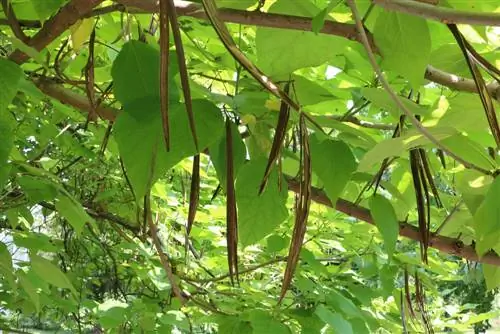
In the wild, Catalpa bignonioides prefers to grow in moist and fertile clay soils. However, if the lime-tolerant exotic is planted in the home garden, the soil should not be too nutrient-rich. This promotes the sprouting of new shoots, which, however, do not mature sufficiently until winter. This often results in the tips of the shoots freezing back and breaking more easily in a storm. Although the common trumpet tree does not place particularly high demands on the soil, it thrives best when the following requirements are met:
- sandy to loamy
- moderately moist to moist
- well drained
- slightly alkaline to slightly acidic
- optimal pH value: 5.5-7.5
Tip:
High-quality potted plants or a mixture of compost, garden soil and sand are suitable for cultivation in the pot. If you don't have compost on hand, you can also use humus-rich potting soil.
Planting
If the trumpet tree is purchased as a container plant, it can be planted all year round. For bare-root specimens, however, it is recommended to plant them in autumn or spring. The latter is generally the best time for planting, as the shoots sprout late and need enough time to develop before frost sets in. This also allows the tree to grow well and take root sufficiently. Before the Catalpa bignonioides takes its place in the home garden, it should first be prepared for planting. To do this, the root ball is dipped into a bucket of water and only removed again when no more air bubbles appear. The exotic can then be planted as follows:
- Dig up planting hole
- this should be twice as big as the root ball
- Enrich excavated soil with humus
- Insert tree carefully
- do not press the roots
- Insert 1 to 3 wooden stakes next to the root ball
- Tie wooden post and tree trunk together
- Fill the planting hole with the mixture of soil and humus
- ideally incorporate a handful of horn shavings
- Soil well and then water vigorously
Tip:
Creating a drainage layer has proven useful both for cultivation in containers and for heavy soils outdoors. This is created before the tree is inserted and preferably consists of gravel or sand.
Fertilize
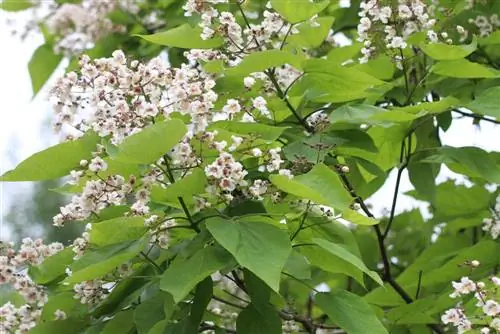
The nutrient requirements of Catalpa bignonioides are moderate, which is why the nutrients present in the soil are usually sufficient. Regular fertilizer application is not necessary, especially for older specimens that are cultivated outdoors. However, mature trumpet trees benefit from fertilization in April, June or August. An organic fertilizer such as horn shavings or compost is best suited for this. The situation is different with young plants, because they do not yet have enough roots to supply themselves with the important nutrients. Therefore, it is necessary to fertilize young trumpet trees in the first few years:
- fertilize every 2 weeks during the growing season
- A complete fertilizer is suitable for this
- this is mixed into the irrigation water
- mineral liquid fertilizers are quickly available
- but are washed out by the rain
- As an alternative, a combination fertilizer is suitable
- with this the components are released slowly
- Combined fertilizer is sufficient for 3 to 6 months
Pouring
The common trumpet tree prefers a moist substrate and should therefore be watered regularly. It is particularly important during the growth phase that the tree is watered evenly because the root ball must never dry out. In addition, the exotic plant produces extremely large leaves. Accordingly, the evaporation rate is particularly high on warm and hot days. In the summer months it is therefore advisable to water the Catalpa bignonioides about two to three times a week. When watering, it is also important to note the following:
- Trumpet tree does not tolerate waterlogging
- reacts to this with root rot
- It's best to water in the morning
- Water potted plants more often if necessary
- then empty the coaster
- this prevents waterlogging
Tip:
To retain moisture in the soil, mulching the soil has proven effective.
Implement
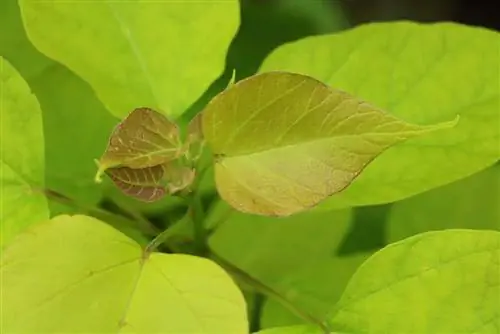
If the trumpet tree is planted in the garden, it can be easily moved after around two to three years. The perfect time for relocation is during the vegetation phase, when the tree is leafless. At this time the ground is still open and the tree can take root well in its new location. When moving, it is important to ensure that the tree loses as little root mass as possible. A jute cloth that is wrapped around the root ball can help and prevents it from breaking apart. The implementation also works best if the following tips are followed:
- Don't insert the tree too deep
- shorten the crown shoots after transplanting
- by about a third or half
- this compensates for the loss of root mass
- It's best to cut in March
- so that any frost damage can be compensated
Cutting
Regular pruning or shaping of the trumpet tree is not absolutely necessary, but it is advisable. Because no cut is made, the crown becomes wider and wider and often loses its aesthetic growth form. It is therefore advisable to thin out and cut the cut-tolerant exotic species every now and then. Older trees particularly benefit from rejuvenation pruning, as this promotes the growth of new, young branches. This involves removing the old and dead wood. In addition, the Catalpa bignonioides can be cut as follows - as required:
Blending
Regular thinning of the tree crown improves ventilation within the crown and at the same time prevents baldness from the inside. When thinning out, all dead branches on Astring are first cut off and all excess or too densely growing branches are removed. The branches are shortened by around 10 to 20 percent overall, cutting above one eye that is directed downwards or outwards.
Topiary
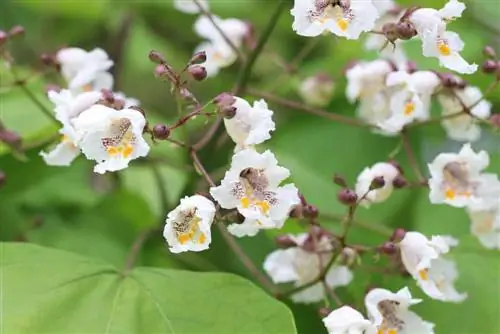
After thinning, it is recommended to carry out a topiary. However, this should not take place annually, but rather every three to five years. This is mainly due to the fresh shoots, which are particularly at risk of breakage. To achieve an airy and manageable crown, the following applies: cut as little as possible and no more than necessary! However, shortening individual branches can lead to broom-like shoots, which means the crown no longer grows round and evenly. That's why topiary is usually carried out using the derivation method:
- shorten branches that are too long
- about a third or half
- place above the pair of buds or bud triplets
- shorten outer branches
- except for a weaker, deeper branch
- at best it grows vertically
- new shoots sprout laterally
- and the shape remains the same
Head tree cutting
The common trumpet tree also tolerates pollard pruning, which is also known as “detopping”, particularly well. This cut is particularly useful if the life of the tree is at risk, for example due to a fungal disease. Pruning is also recommended if the tree has suffered significant storm and/or frost damage. When the crown is removed, the crown is cut off so that only a few leading branches or the trunk remain. It may take a little longer for the trumpet tree to form a crown again. However, after this radical cut, the leaves sprout more lushly and are usually larger.
Wintering
The Catalpa bignonioides only acquires its frost hardiness over time, although it is usually considered hardy from the age of four. A mature trumpet tree can easily cope with sub-zero temperatures, as it only becomes problematic for it from -28 degrees. Young trees, on the other hand, are not considered hardy in the first four years. These are particularly susceptible to frost cracks, especially when there is strong frost combined with strong winter sun. It is therefore advisable to provide frost protection, especially for young trees.
- Roll reed or bamboo mats around the trunk
- Mulching the root area
- Put breathable fleece over tree at night
- White paint
- bring young trees indoors
- A garage or an unheated winter garden is suitable as winter quarters
- Don't overwinter too warm!
Tip:
To prepare the young trumpet trees for winter, they can be sprayed with comfrey manure in August and September. Because the manure is rich in potassium, which strengthens the cell walls.
Propagate
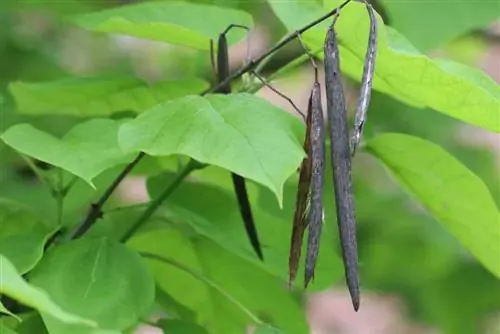
The common trumpet tree forms depressions over time, but these should be removed in good time. It is better to propagate the tree specifically either through seeds or cuttings. For propagation through seeds, it is first important that they are soaked in lukewarm water for around 24 hours before sowing. The seeds are then sown as follows:
- Fill the planter with potting soil
- moisten the earth
- Place seeds in the soil and cover with substrate
- cover with a glass or foil
- place in a partially shaded location
- optimal temperature: 18 to 23 degrees
- Remove cover regularly
- this prevents mold formation
- Germination time is about 5 to 8 weeks
- then carefully repot the seedlings
If you want to propagate your trumpet tree with cuttings, choose a shoot that is around 10 centimeters long in early summer and cut it off from the tree. If possible, the cutting should be cut at an angle so that the cutting can absorb the water better. The lower leaves are then removed, leaving only the top pair of leaves. Now the cutting can be placed in potting soil and placed in a partially shaded location. It is important that from now on the soil is always kept moist and direct sunlight is avoided.
Diseases and pests
Verticillium wilt is particularly common for Catalpa bignonioides. In this fungal disease, the fungus spreads through the ducts and prevents the supply of nutrients and water to individual branches. The fungal disease cannot be cured, which is why the affected branches wilt and die. However, young trees can sometimes be saved by transplanting them. The fungal disease can also be prevented by ensuring nutrient-rich soil and using plant strengtheners. The common trumpet tree is also susceptible to diseases such as powdery mildew and scald fungus. It is also often attacked by the following pests:
- Caterpillars
- Snails
- Aphids
- Spider mites

